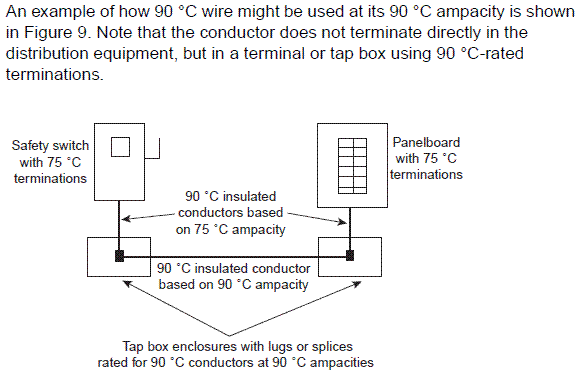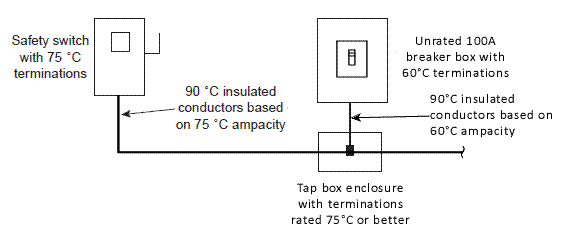iMuse97
Senior Member
- Location
- Chicagoland
2. What is the typical operating temperature of wire when installed in a code compliant manner, loaded continuously to 80% of ampacity with a 35*C?
This is supposed to say: with a 35*C ambient temperature?
2. What is the typical operating temperature of wire when installed in a code compliant manner, loaded continuously to 80% of ampacity with a 35*C?
=Smart $;1108116]Not possible. If there is current through the tap conductor, it has to be some of the current flowing through the 500
That would be fine if we met the ampacity of 500's at 60?C. The requirement says, "...shall be selected and coordinated so as not to exceed the lowest temperature rating of any connected termination, conductor, or device." Conditions stated exceed that value.
The 100A ocpd is at the load end of the tap conductor... but even that don't matter. Any current passing through the tap conductor must pass through the 500 it is connected to.The only current flowing through the tap conductors should be the load from the 100 amp OCPD.
I believe you are basing your premise on using different ratings at each end of the conductor. The code as written does not make that distinction, though I agree in principal that it should provided there be adequate distance between ends of the conductor.The #1 AWG conductors insulation would have 75 degree insulation. But would not exceed 60 degree from the 100 amp load.
So they would be able to handle the temp at the 500 term. but would not exceed the temp at the 100 amp breaker.
110.14 says the ampacity of a conductor shall be selected and coordinated so as not to exceed the lowest temperature rating of any connected termination, conductor, or device.
I never thought of the rule in 110.14 for this type of application. It says it's based on the ampacity of the conductor.
The tap conductors would only have the ampacity from the 100 amp OCPD. While the 500's will have the ampacity of the tap conductors plus the ampacity of what ever else they supply.
=Smart $;1108122]I believe you are basing your premise on using different ratings at each end of the conductor. The code as written does not make that distinction, though I agree in principal that it should provided there be adequate distance between ends of the conductor.
Let's use extreme examples to make the point. The length of your #1 conductor is just barely long enough to make terminations to both the feeder and the device. Under this circumstance, what is the temperature of the tap conductor at the ocpd when the 500 feeding it is at or very near 75?C.? If we locate the ocpd 300' away (outside) would that temperature be any different?
We could debate this issue seemingly forever (or until the code is changed) and not reach any concrete conclusion...
If I where installing this I would just use a breaker with a 70 degree rating. But it sure is fun to debate these types of issues.
You know I just realized something. If the tap has to be rated at 60'C then the 500 MCM cable must also be rated at 60'C in accordance with NEC 110.14(C). This would limit the ampacity of the 500 MCM cable to 320A.
The tap conductor can't exceed 60 degree but has to be able to handle the 500's 75 degree.
110.14 doesn't say anything other than the temperature rating associatedwith the conductor ampacity can't exceed the lowest temp.
The #1 AWG is the only conductor terminating on a 60 degree term and is sized as such.
I said I was reaching. What you are saying is how I always understood the rules of 110.14. Once again I would just put a 75 degree breaker in.It seems you're standing on this by yourself. That's fine.The whole mass of humanity (actually just 5 or 6 electricians or EEs), is on the other side of this one, but that's OK, too.

110.14(C)(1)(a) says the termination provisions apply to all the terminations on the circuit:
"Termination provisions of equipment for circuits rated 100 amperes or less, or marked for 14 AWG through 1 AWG, shall be used only for one of the following:"
You are trying to mix the flavors, that is, use two of the options on one circuit. As I read it, NEC says no.
But that's OK. We disagree. As Smart says, we could keep going, but I don't suppose we need to.
I said I was reaching. What you are saying is how I always understood the rules of 110.14. Once again I would just put a 75 degree breaker in.
But for more debate is the entire circuit really rated at 100 amps or less? Or with the 500,s on the 400 amp OCPD do we have 2 circuit ratings???? Thats where I've been leading my discussion. I've never applied the rules of 110.14 to a tap conductor situation so it's interesting to try to get pepole to think outside of the box.
I guess what I'm reaching at is how I am interpreting 110.14 (C) (the conductor ampacity). The 500's don't land on the 60 degree term so in no case should their ampacity affect the tap conductors at the 100 amp breaker.
But as you know, Code doesn't always care how sensible it may seem to us... I agree that it makes sense (of the common sort) to create an installation like you suggest.
However, I think it is not talking about conductor ampacity first of all but about the "temperature rating associated with the ampacity of a conductor." This (the temperature rating), it seems to say, "shall be selected, and so on..."
I interpret the "any connected term, conductor, or device" to mean that the 500's are connected, and that the temperature rating associated with it will be based on the 60*C rated terminal on the 100A breaker that you would not install, because you would install one with terminals rated for 75*C.
Why would you tap a 500MCM with a load of 380a anyway ?
I guess what I'm reaching at is how I am interpreting 110.14 (C) (the conductor ampacity). The 500's don't land on the 60 degree term so in no case should their ampacity affect the tap conductors at the 100 amp breaker.
I know I have maintained the position your installation as proposed would not be permitted... but that is mostly influenced by the general consensus I have gotten from this(these) forum(s). However, as I said above, I know a proper "tap" can be made, leaving the NEC validity aside.NEC 110.14(C) clearly states that a conductor connected to another conductor shall not exceed the lowest temperature rating. The 500 MCM cable is connected to the tap conductor which is rated at 60'C because it is connected to equipment which is rated at 100A and therefore must be rated at 60'C. Look's like the whole system including the 500MCM cable has to be rated at 60'C.


That part I disagree with. I believe it only pertains to direct contact, not indirect.Look's like ... the 500MCM cable has to be rated at 60'C.
